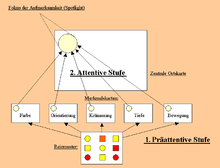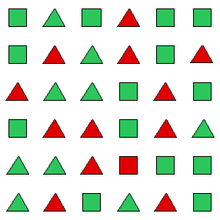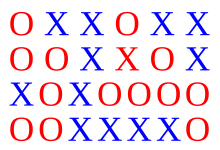Feature integration theory
The feature integration theory (in the original Feature Integration Theory ) by Anne Treisman (1963) is a theory that the human object recognition using visual attention explained.
The starting point for Treisman's views is the filter theory of attention by Donald Broadbent from 1958, which states that there is a so-called "filter" in the brain that selects stimuli on the basis of physical characteristics ( early selection , in contrast to this see for a better understanding also: Theory of the late selection by Deutsch & Deutsch, 1980) Since neither (Treisman - Deutsch & Deutsch Kontroverse) could give a clear answer, an alternative from Lavie followed in 1995: not the place of selection (early / late), but the requirement on the target situation determines the interference.
Division into levels
Preattentive processing
The features of the not yet recognized object are initially free and simply next to each other (float free). This process is known as the pre-attentive processing stage and is fast, automatic, and unconscious . Similar features (e.g. blue) form dimensions (e.g. color). The dimensions are each dependent on detectors that are sensitive to the corresponding features. Similar detectors are again organized in feature maps. There is therefore a separate feature map for each dimension. A specific location on these maps corresponds to a specific location in the visual field ( retina ) that responds to stimuli that fall on that area of the retina.
Attentive processing
These matching locations of different maps are assigned to one another by directed attention in the next stage of the attentive processing, because here the features are combined to form an object, which represents a bottom-up processing (see top-down and bottom-up ). Via a central location map, the output signals of the detectors of all feature maps are available at the one place where the focus of attention is at the time. This links the features together. With the required directed attention, this process takes longer than pre-attentive processing. Treisman compares the focus of attention with a kind of light cone ( spotlight ): if the object is within the "light", it can be perceived as a unified whole.
Four paradigms
Treisman used four experimental paradigms designed to support this stage theory. So z. B. different reaction times indicate either pre- attentive ( short reaction time) or attentive (long reaction time) processing.
The paradigms are:
- Visual search
- Illusory conjunctions (connections)
- Texture area separation
- Identification and localization
The visual search is most important here.
Visual search
The visual search for a possible target stimulus takes place in a search display which contains a variable number of distractors. The total number of target stimuli and distractors presented is called the display size . The test subject has to decide whether there is a target stimulus on the display in addition to the distractors. The characteristics of the distractor can differ from the characteristics of the target stimulus in only one dimension, such as color, shape, movement, etc. (single feature search) or in a combination (conjunction) of several characteristic dimensions (feature conjunction search).
The parallel search is carried out pre-attentively (without attention), as the target stimulus differs in its characteristic from those of the distractor and immediately catches the eye ( pop-out effect ). This is only possible if there is only one variable feature (single feature search). The display size has no influence on the response time. The pop-out effect can be overlaid by evolutionary processes: an angry face in a crowd of happy faces pops out; but not a happy face in a crowd of angry faces.
If the display is searched for a target stimulus that is composed of various features of the distractor (feature conjunction search), one speaks of a serial search . Directed attention is required because the test person has to "scan" the entire display in order to discover said target stimulus. The search rate is more than 10 ms per item, with the response time depending on the display size (the larger the display, the longer the response time).
Depending on whether there is in the display, a target stimulus or not, in the serial search between the self-terminating Search (self-terminating search) and the exhaustive search (exhaustive search) distinguished. In the self-canceling search, the display is only searched until the target stimulus has been found, which of course is only possible if it is actually present. This happens on average after half of the items have been searched. In the exhaustive search, all display items are searched before it can be determined that there is no target stimulus. As a result, the ratio between the duration of an exhaustive search and the average duration of a self-canceling search is 2: 1.
Texture area separation
The texture area separation is a parallel process that requires no attention. Only targets that differ in one feature are suitable for this, i. H. only features and no conjunctions.
Illusory conjunctions
In the second stage of the feature integration theory, as already mentioned, the features from the first stage are assembled into a coherent object with the help of directed attention. However, if the attention is not focused on the particular place where the object is located, there is a risk that the features will be incorrectly linked to one another, thus creating an illusory conjunction .
Identification and localization
If the target differs from the distractors in only one feature, it can be identified without knowing exactly where it is on the display. In other words, with the feature condition, identification and localization work independently of one another. With the linkage condition, however, the target must be localized with the help of directed attention (i.e. on the second level). Only then can it be identified.
literature
- Deutsch, J. & Deutsch, D. (1963). Attention: Some theoretical considerations . Psychological Review, 70: 80-90.
- Goldstein, BE (2002). Perceptual Psychology . Heidelberg: Spectrum Academic Publishing House.
- Müsseler, J. & Prinz, W. (2002). General psychology . Heidelberg: Spectrum Academic Publishing House.
- Treisman, AM & Gelade, G. (1980). A Feature Integration Theory of Attention . Cognitive Psychology, 12, 97-136. ( PDF )
Web links
Individual evidence
- ↑ Christine and Ranald Hansen (1988): Finding the Face in the Crowd: An Anger Superiority Effect . Journal of Personality and Social Psychology, 54, pp. 917-924







